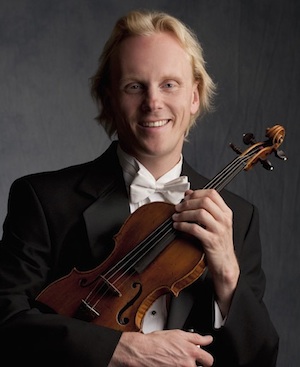A Concertmaster's Solo Debut and an Insightful Shostakovich
Dale Barltrop, violin and Gunther Herbig, conductor
Works by Beethoven, Schumann, and Shostakovich, Orpheum, October 23, 2010
It was a fine gesture of the VSO to feature the solo debut of its young new concertmaster, Dale Barltrop, so early in this concert season. The rarely-performed Schumann Violin Concerto was chosen for the occasion. Venerable conductor Gunther Herbig extended the celebration by an insightful rendering of possibly Shostakovich’s greatest orchestral work.
Dale Barltrop
The Schumann concerto (1853) has an unfortunate history. Its dedicatee, legendary violinist Joachim, regarded the work as a product of the composer’s declining mental powers, and did not perform it. After years of dormancy, it was premiered only in 1937 by Georg Kulenkampff. While possessing strength and momentum in the opening movement, followed by a touching interlude, the work still remains somewhat dogged and overwritten, not nearly possessing the thematic variety of the famous Piano Concerto. I think Dale Barltrop took the right approach here: to play the work freshly and lightly, and not make it emotionally bigger than its structure can take. He did an excellent job. His playing was clean, communicative, and alive, and he managed to bring both continuity and variety to the writing. Virtuoso passages were always tempered with enough restraint to avoid becoming overwrought or merely busy. The violinist seemed totally at the service of the music. A fine solo debut!
Gunther Herbig’s own contribution was equally interesting. From the first few bars of the opening overture, Beethoven’s Coriolan, one could see why Herbert von Karajan liked this conductor so much. His orchestral control is superb, his ability to get a smooth, glowing texture from the strings is masterly, and he builds orchestral climaxes decisively.
In the Shostakovich Symphony No. 10 (1953), these qualities led to a more central European, rather than Russian, interpretation of this work. Russian performances can tend to be rather ‘raw’ and theatrical since they aim to reflect Shostakovich’s extreme emotional response to Stalinist excesses, among other things. Thus, they dramatically contrast passages of quiet, icy bitterness with bold, and almost brutal, passages of disdain played by the full orchestra. Herbig instead sought a smoother, more objective symphonic integration between these extremes and a warmer overall emotional tone. In many ways, the link is to the symphonies of Gustav Mahler, a composer that Shostakovich admired deeply.
Gunther Herbig
From the quiet opening of this work, phrases were more ‘shaped’ than usual. The string textures and feeling indeed hinted at Mahler’s 9th Symphony, more regretful than bleak. As the work opened out to the bold, quasi-militaristic climaxes, these seemed more like satisfying musical resolutions than obvious political statements. The same in the following scherzo, which is one of the more savage pieces in the composer’s output. From the whiplash violins to the menacing brass, one noticed only the immense symphonic power of the writing. True, there were places in the last two movements where this approach did seem slightly off-line, and the final climax perhaps came a little quickly, but overall Herbig’s vision and control were very convincing. The conductor and orchestra received an extended standing ovation for their efforts. Interestingly, the conductor has just released a CD of Mahler’s 9th Symphony on Berlin Classics 17952.
© Geoffrey Newman 2010

